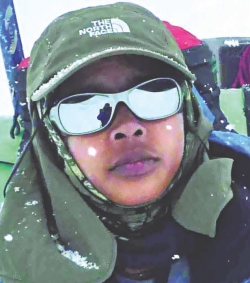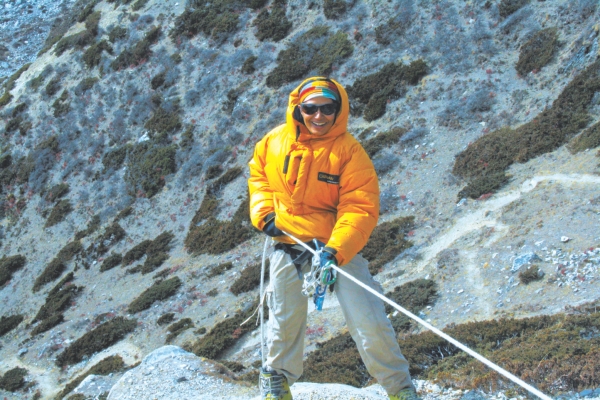| Home - Back Issues - The Team - Contact Us |
 |
| Volume 11 |Issue 24| June 15, 2012 | |
|
|
Achievement A Reason to Believe Naimul Karim
"I tried climbing Everest the second time only because I wanted to go by the route that Edmund Hillary took when he scaled the summit… I never expected it to be so dangerous though!” exclaims MA Mohit, as he recalls the fatal moments of the expedition that almost took his life. The 41-year-old, who is the only Bangladeshi to have climbed the summit from both sides— the north-eastern ridge in Tibet and the south-eastern ridge in Nepal—describes the latter route as 'twenty times more difficult' to scale. "While the route in Tibet was a lot more cold and windy, it however, was safer. On the other hand, the path in Nepal was a lot more dangerous. We met with an avalanche and there was a danger of getting hit by the 'Khumbu' icefall," he says. Nishat Majumdar, who was in the same team, along with two other Nepali climbers, almost got killed after the avalanche nearly dumped her into a crevasse—a deep gap in the ice. "The region where the avalanche caught us is generally considered to be a safe area. To my right there was the Nuptse Mountain, to my left there was the Lola and in front of us we could see Everest, next to the Lhotse Mountain. We were surrounded by huge mountains and it was an unbelievable sight," recalls Nishat, the first Bangladeshi woman to climb to the top of Mount Everest. As the mountaineers took a break, they noticed a huge pile of snow and ice falling fast from the Nuptse. "Initially, we didn't expect the avalanche to hit us since we were around 250 feet away from the mountain. But moments later, the Nepali climbers realised the danger and shouted safety! That was our cue to gear up and tie our belts," explains Mohit. While the three climbers moved into 'safety', Nishat was busy taking photos. "I didn't hear the call and I didn't expect the avalanche to reach us," she recalls. As the huge pile of snow came charging towards her, Nishat tried her best to hold on to something. "I was desperate at that point and tried to grab on to whatever I could…but everything around me was just ice."
At the end of the dangerous episode, Nishat found herself on a glacier, 30 feet off track and a few metres away from a deadly crevasse. "Things would have been way different today if I had fallen into that hole. I don't think they would have managed to find me then," she says with a wry smile on her face. While Nishat had fallen onto an ice sheet, Mohit and the other climbers covered their noses in order to prevent the snow from choking them. "We had to hold our breath for at least three minutes. At one point it seemed like the avalanche would never end," says Mohit. The flurry of snow and ice ended up injuring a Sherpa climber— a person, who belongs to the mountainous regions of Nepal—who was later sent back in a helicopter. "That incident set the tone for us," claims Mohit. "Surviving the avalanche gave us a new-found confidence and ever since then, we never looked behind." As it so happened, the deadly avalanche wasn't the only obstacle that they faced in their bid to reach the summit. A fierce-looking hanging glacier almost pierced through their tent, while they were at camp-3. "A hanging glacier was racing towards us just as we decided to leave our tents and continue climbing. We were all asked to protect our heads. I instantly reached for my helmet and crossed my fingers," says Nishat. At the end, the big ice pieces missed them by a whisker, ended up hitting another tent and brutally injured a Sherpa inside it. "To me, that was a lot scarier than the avalanche. I really didn't think we'd be able to survive the glacier," narrates a wide-eyed Mohit, re-living the entire incident in his head. Despite the deadly incident, the team never looked back. As the sun rose on the 19th of May, Nishat and co pierced the last ice on their way to the summit and finally reached their destination. “It might sound like a cliché… but you really can't describe the feeling in words. The adrenalin rush… the pain….the natural beauty, it was a mixture of many things,” says Nishat, as she recalled the way she felt at the peak. While Nishat became the first Bangladeshi woman to conquer Everest, Mohit extended his own record by climbing a 'VIP' mountain— more than 8000 metres long— for the fourth time. While both the climbers were proud of their individual achievements, they however, were wary of the support they got from each other and the other members of their team. “When we climb, we climb as a team. It's necessary that the members of the group know each other and perform well together. After all, we were in an unknown environment for so long!” claims Nishat. And that proved to be a disadvantage for Wasfia Nazreen, who reached the summit a week later, on 26 May, with the help of two Sherpas. She eventually became the second Bangladeshi woman to reach the peak. “I usually go to expeditions with people I know, it provides an encouraging atmosphere and helps you deal with issues such as loneliness and various other factors,” explains Wasfia. “The volatile environment up there gets to you after a while,” she adds. A rights activist and a practitioner by profession, Wasfia aims to conquer the highest summits of each continent, thereby representing the progress of women in Bangladesh. Mount Everest, she claims, was the 'most difficult' peak to scale. “It was three months long and I saw many of my close friends get injured. The unpredictable weather added to the misery. Everything together painted a bleak picture,” she recalls.
Wasfia, like Mohit and Nishat, had her share of near-death experiences as well. The Yellow Band, a distinctive rock on the Lhotse Mountain, which requires around 100 metres of rope to cross, was one such area where Wasfia found herself in trouble. “While I was descending on the Yellow Rock, my rope got over and I had to fix another one to get down. But then I suddenly slipped and was hanging at a 'free-falling' position, until a Sherpa came and saved my life!” narrates Wasfia. Calling the Sherpa 'an angel in disguise', the mountaineer describes the climb down the yellow band as the 'scariest moment' of her life. Despite the nervous moments, the 29-year-old remains upbeat about her mission to conquer the remaining summits. “I definitely am climbing the other summits, although, it'll be a while before I go to my next expedition. The Everest Summit was longer than expected.” Both Mohit and Nishat shared similar views when asked about their future plans. While Nishat aims to conquer Everest, via Tibet, in the future, Mohit plans to scale all the summits above the 8000 metre range. The manner in which the mountaineers fought the near-death experiences, defies belief. Perhaps what's even more enduring is their 'hunger' to achieve many more climbing accolades, despite having conquered the most difficult one. The fact that people with such unorthodox dreams in life still exist in this country, is an achievement in itself; and by conquering them, the mountaineers have given the millions of Bangladeshis a reason to believe.
Copyright
(R) thedailystar.net 2012 |


